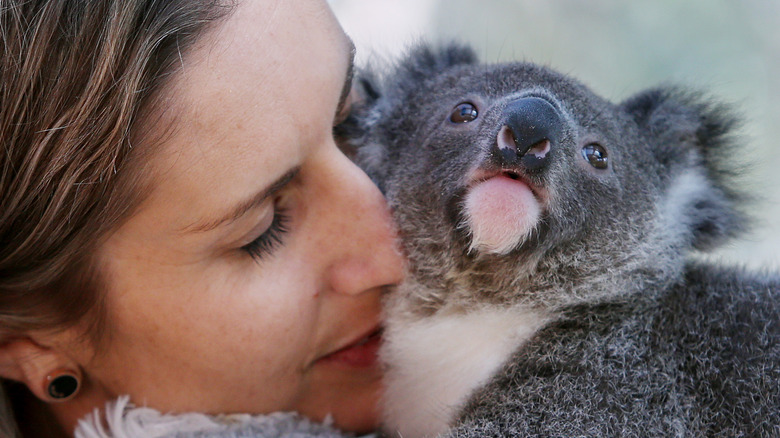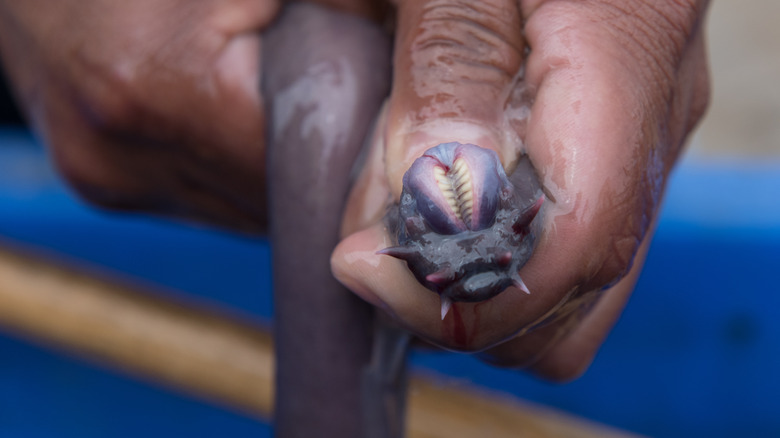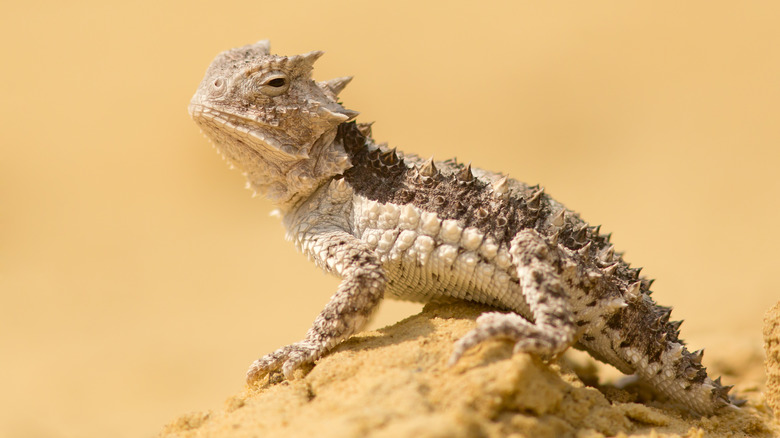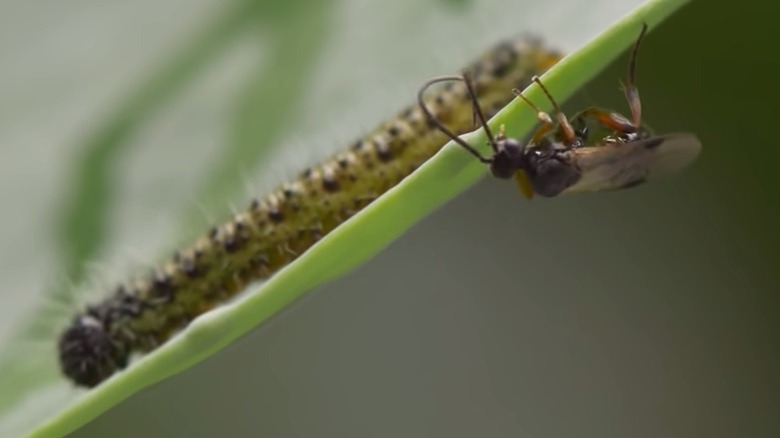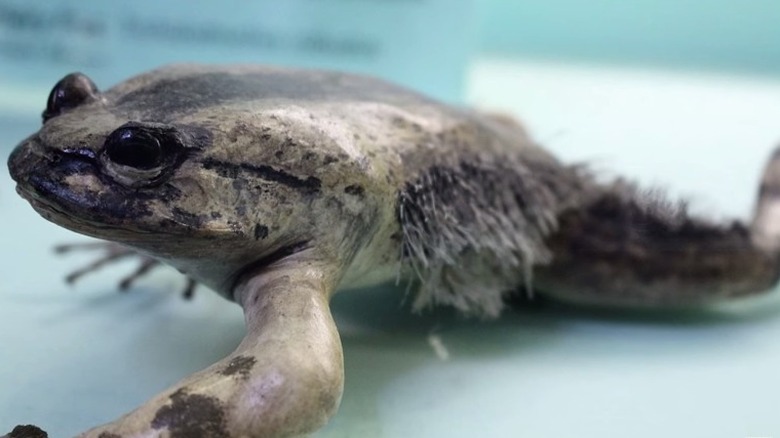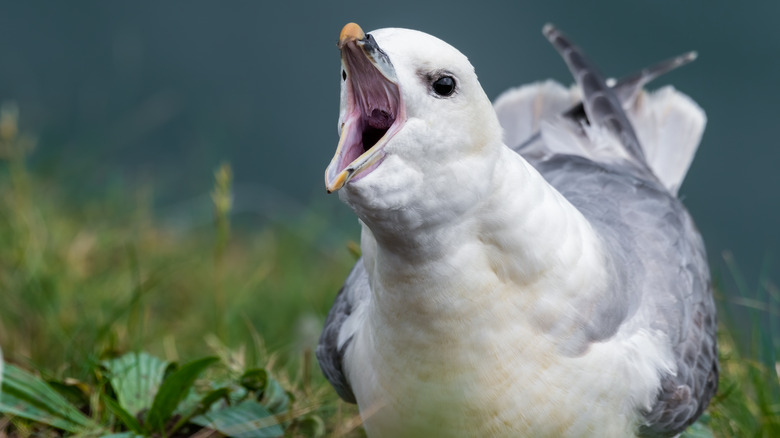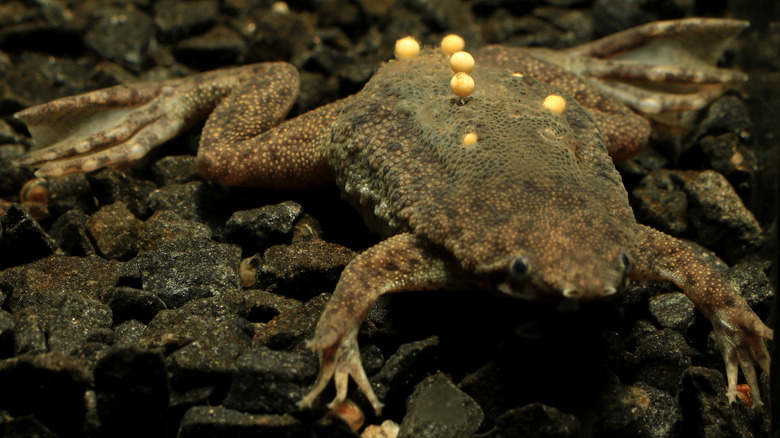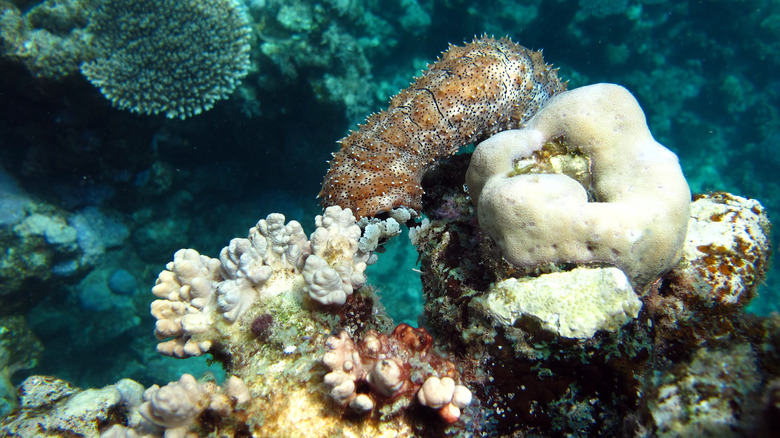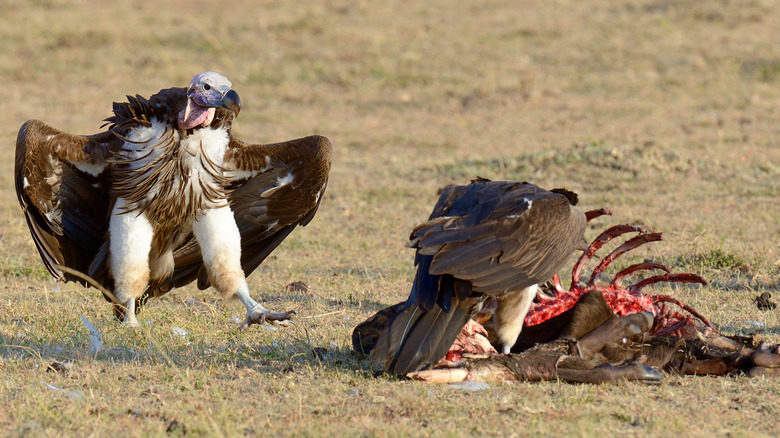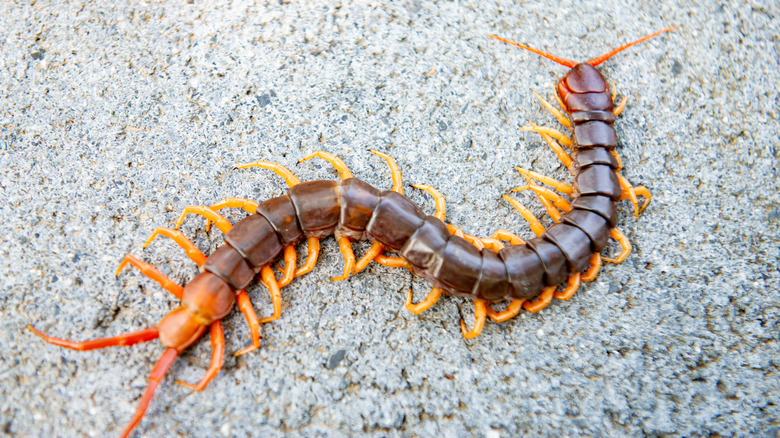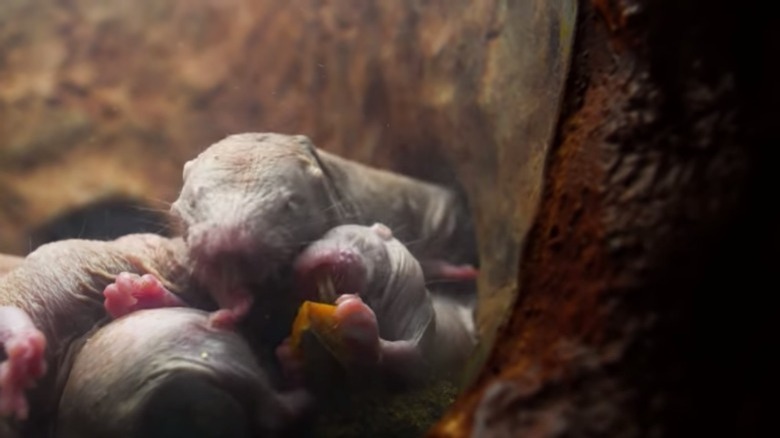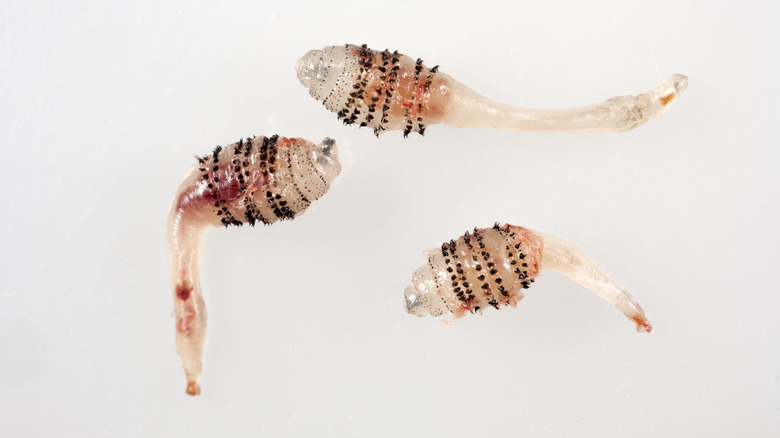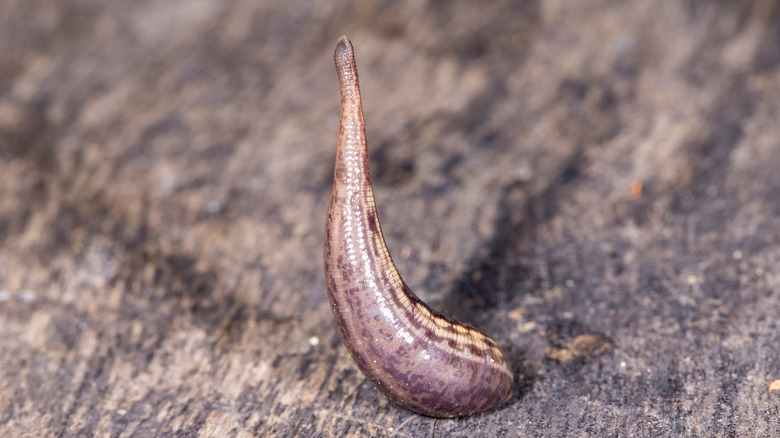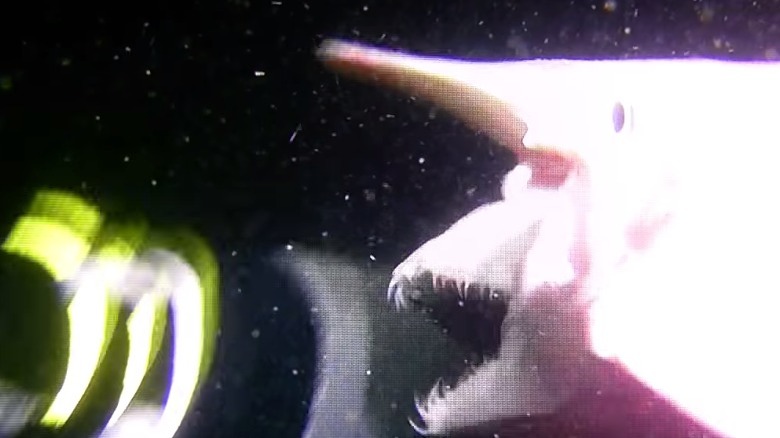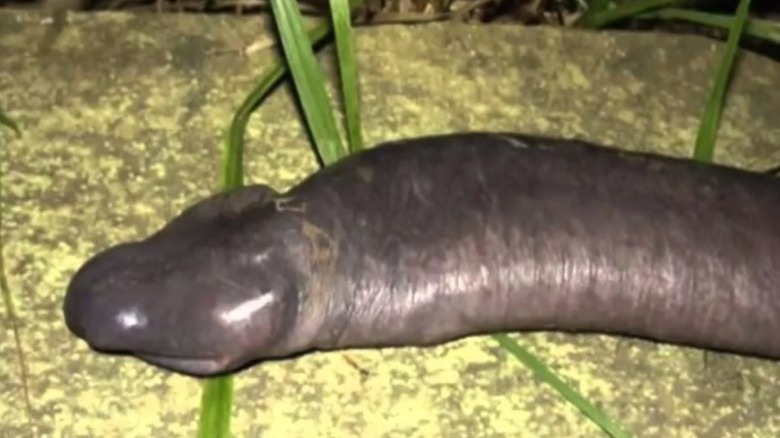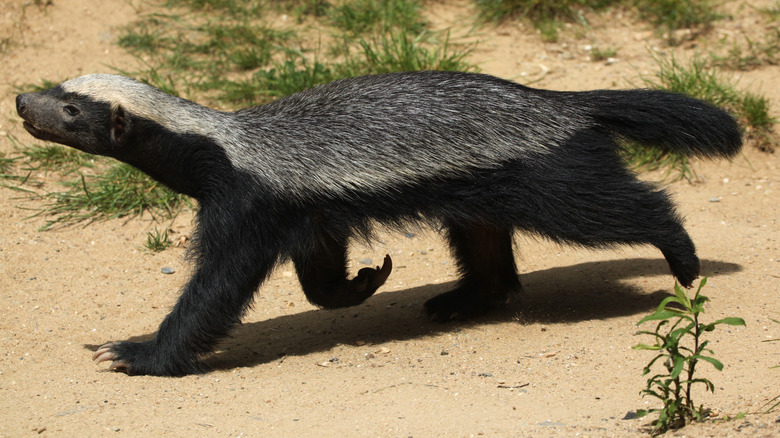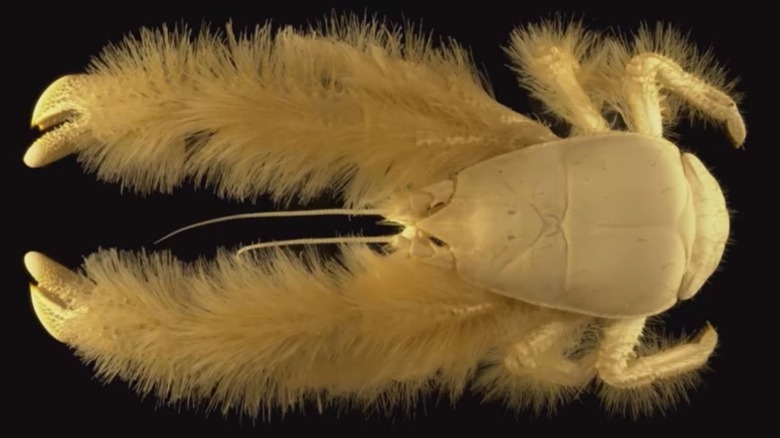These Are The Most Disgusting Animals On The Planet
The natural world is a beautiful thing. Across the planet, contrasting landscapes from the deserts of the Sahara to the ice sheets of Antarctica offer habitats for a plethora of lifeforms. Majestic mammals like the lion and the wildebeest, glorious soaring birdlife such as the golden eagle and mighty condor, and mysterious, magical sea life — the blue whale, the basking shark — all call Earth home and manage to survive and thrive in some of the most unexpected places.
In this increasingly urbanized, interconnected world, we are repeatedly reminded that we have to make time to reacquaint ourselves with the natural world from which we sprung. But the truth is, not everything on Earth is as charming as the above paragraph might suggest. Of course, every living thing on this planet has its place, but after reading this list chances are that you'll be more than happy to give the natural world a miss for quite some time.
The slimy hagfish
Most fluids excreted by the world's wildlife are pretty gross, but you know that things are getting especially bad when scientists involved in studying a creature freely use the word "slime" to describe what the creature is capable of producing. Especially when the creature looks like this thing: the hagfish, a 300-million-year-old deep-sea beast that really is difficult to love.
Stuck in the middle of the food chain, the hagfish has developed a horrendous yet powerful defense mechanism to help it escape the fearsome jaws of sharks and other large predators. When attacked, the hagfish fills the water with what Britannica describes as "copious" amounts of thick slime that clogs the mouth and gills of its attacker — potentially suffocating it — and allows the wily creature to twist away from the attack and escape. Science reports that the hagfish — also known as the "slime eel" — has the ability to survive shark bites thanks to the comparatively fluid-like nature of its body in comparison to other fish.
If all that isn't disgusting enough, the frankly satanic appearance of the hagfish is because of the fact that it has no jaw, but rather a ring of razor-sharp teeth which it uses to burrow into the flesh of dead whales on the seafloor, according to Wired. After chewing its way into the carcass, the hagfish will then take up residence inside the ex-whale, and feast on it from the inside out. Charming.
Horned lizards squirt blood
Lizards are incredibly diverse, with over 6,000 unique species found all over the planet, and with some basically unchanged since the Early Jurassic epoch. Some species — such as the sticky-fingered gecko or the color-altering chameleon — are undeniably cute despite their cold-bloodedness. But this reptile group also boasts some of the most repulsive creatures on the planet that you certainly wouldn't want to encounter out in the wild.
On the face of it, the horned lizard has a rather appealing look about it. A small, toad-like reptile found in North and Central America, its stout body is covered in impressive spikes that give it the look of a baby Godzilla. However, as the horned lizard is potential prey for many wild animals, the species has developed a truly gross defense mechanism.
As described by the BBC, the horned lizard has developed the ability to pool blood in sacs called the "ocular sinus," below its eyes, and is able to squirt its contents at will up to a distance of 6 feet. This jet of foul blood is typically aimed right in the mouth of potential predators such as coyotes, which are repulsed enough by the disgusting taste that the prickly reptile is able to escape from harm.
The glyptapanteles wasp turns caterpillars into zombies
You'd be hard-pressed to find somebody with an enthusiasm for wasps in the same way that some people have a "thing" for lizards, snakes, or even spiders. Though scientists are now keen to remind us that many species of wasp are pollinators and therefore are beneficial to humanity in the same way as loveable bees. However, wasps tend to be way more aggressive than their fuzzier, honey-making counterparts ... while the rise of murder hornets in North America hasn't done much to help improve public opinion about wasps one bit.
In truth, all wasps are pretty horrible. But there is one species that is more disturbing than most: the glyptapanteles wasp, the lifecycle of which is enough to shake even the most stubborn optimist's belief that nature is all things bright and beautiful. As New Scientist describes, the larvae of the glyptapanteles wasp are parasitic, beginning life after hatching from a clutch of up to 80 eggs laid in the body of a defenseless geometrid caterpillar on which the larvae will feed, until they eat their way out of the body and form cocoons.
So far, so grimly parasitic. However, there is one added stage that really raises the fear factor here. Scientists have observed that the mortally wounded caterpillar then sticks around, defending the cocoons as if under a form of zombie mind control, putting itself on the line to bat away any approaching insects that might threaten the infant wasps, before finally dying. Freaky, right?
The freakiest frog of all time
Culturally, frogs are pretty divisive. For some, they are enough to elicit the same phobic reaction that many of us feel on encountering snakes, rats, or spiders. For others, they're cool, or even cute — does anyone really have a problem with Kermit?
Some species, such as the poison arrow frog, are profoundly deadly, but it isn't the world's most poisonous frogs that have been raising eyebrows in the internet's wildlife communities in recent years. Rather, it is the Central African Trichobatrachus robustus – aka the "hairy frog" — that has been getting all the headlines, with New Scientist referring to the species as the "horror frog."
The creature has risen to prominence because of two rather unnerving physical attributes. The first is the presence of thick, mane-like hair that adorns the flanks and hind legs of the male of the species, giving the frog the appearance of a frog-wolf hybrid. According to Scientific American, it is believed that this feature increases the frog's ability to remain underwater for longer stretches when guarding the female's eggs. Second, the hairy frog has been shown to have claws — that's right, claws — made of bone that burst through the toes of its hind legs, and which are believed to be used in "interspecific combat," per the same source. No wonder this species has yet another nickname: the "wolverine frog."
You really shouldn't pet koalas
Koalas are up there with pandas and capybaras are some of the world's most loved animals. They're super-cute, big-eyed, docile, and utterly cuddleable. All they want to do all day is hang around and eat eucalyptus — an admirable lifestyle in today's jingle-jangle world. But the fact is, koalas aren't quite as wholesome as they first appear. According to Life Science, the marsupials are riddled with chlamydia, with some 40% of those brought into sanctuaries affected by the sexually transmitted disease. Not so cute now, right?
In 2012, The Metro reported that the members of One Direction were growing concerned for their sexual health after being peed on by koalas they were cuddling at an Australian animal sanctuary, and quoted Liam Payne as saying: "I'm genuinely scared. This is worrying. I'd have never picked the thing up if I'd known."
So if you still can't resist the pull of their big eyes and you're planning on getting up close and personal, you may want to don some gloves. (Clarification: I'm talking about koalas, not One Direction, who denied having contracted the disease in 2017, per NME).
Never mess with a fulmar
To most laymen, the fulmar looks like any other seabird — indeed, it could easily be mistaken for a regular seagull. Found in the North Atlantic, North Pacific, and exclusive to Alaska in the U.S. according to All About Birds, the species isn't especially notable in the same way puffins or penguins are.
But as many climbers will confirm, there is one thing about this bird that is especially vile and therefore makes the fulmar worth avoiding at all costs: its ability to vomit. According to Blasting News, the fulmar — the name of which derives from the phrase "foul gull" — defends itself by firing jets of foul-smelling oil, which it produces especially to repel would-be predators. Fulmar chicks are especially happy to produce a squirt of the gross liquid when its nest is invaded. While the effect on most four-legged visitors is to make them think twice about re-entering, for other birds who get hit by the sticky liquid the consequences are far direr, as the oil has the effect of gluing their feathers together, instantly impairing their ability to fly and often sending them to their deaths in the sea below.
Suriname toads give birth horribly
Toads aren't known for their good skin — in fact, they're not prized for their appearance in general. And the Surinam toad is perhaps one of the ugliest toads around, a flat-bodied, moon-eyed blob that has evolved to resemble a wet leaf, according to San Diego Zoo. But it is not simply its looks that get the Surinam toad a place on this list.
As described by National Geographic, the reproductive cycle of a Surinam Frog is pretty stomach-churning. It starts romantically, with the mating pair "somersaulting" together through the water for up to an hour. Then, the female releases around 100 eggs for the male to fertilize. In usual toad reproduction, this is where parental involvement ends, with the eggs left alone to hopefully form into tadpoles and then into young toads. But in the case of the Surinam frog, another rather weird step takes place. The male bunches all the fertilized eggs on top of the female, who then forms a thick layer of skin so that the eggs are encased in her own back to protect them from predators.
Thus protected, the offspring transform from eggs into fully-formed toads before bursting out of their mother's back and swimming to freedom, leaving a barrage of birthing holes behind them. Yuk.
Sea cucumbers are just really weird
The name "sea cucumber" has always seemed a bit of a joke. Though this freaky organism is long, in no way else does it resemble that innocuous and inoffensive fruit, starting with the fact that it's actually an animal — and a pretty gross one at that.
According to Thought Co, a sea cucumber is basically a tube with a mouth and an anus at opposite ends, but, unlike, say, a worm, a sea cucumber actually has feet, which are tiny and located around the rim of its mouth. As well as being used to anchor the creature to the ocean bed, they are also tools for identifying minute pieces of food among the sand. Not too gross in itself, but that's just to whet your appetite for the next two tidbits that are to follow.
First, the sea cucumber breathes through its anus. That's right: they actually suck water in and out of there, which contains what is called a "respiratory tree" to keep themselves oxygenated. According to National Geographic, their need to keep their butt opening and closing in such a way also means they become host to other creatures, such as the pearlfish, which is happy to make its home in a sea cucumber's anus (and which therefore could be on this list all on its own). And second, the sea cucumber is capable of what academics (via Research Gate) call "evisceration," a mechanism by which it can expel at will its internal organs. Per Thought Co, this may occur when the creature is stressed or suffering from a chemical imbalance, but it may also occur to save the sea cucumber from predators, in the same way a salamander might shed its tail as a decoy before fleeing a predator.
Vultures are grosser than you think
Vultures have long been seen as a bad omen, most often seen circling in the air awaiting the deaths of the protagonists of Hollywood movies as they run out of water in a desert or risk getting stranded up a godforsaken mountain, or else picking through the human remains of a corpse-strewn battlefield. Gross as it is, these otherwise majestic birds are almost exclusively scavengers, with the disturbing ability to detect the scent of rotting flesh — which releases a specific set of chemicals — from over a mile away, according to Live Science.
Per the same source, their scavenging also accounts for the unappealing featherless look of their heads. "The birds are designed to poke their bills deep into a carcass," Paul Wolterbeek told Live Science, "and smooth skin cleans a lot more easily than would absorbent feathers." In such a way, a vulture can strip a cadaver entirely of its meat in under 30 minutes (per Sea World) Ugh.
But if being designed to dive neck deep into decaying flesh isn't enough to put you off them, there is a second gross fact about vultures, which is that they regularly pee all over their own legs. According to The Spruce, this action is performed to "cool off," but it also serves the purpose of neutralizing bacterial infections that the vulture might pick up through its feet. Fun fact: one person who shares this habit with vultures is Madonna, who recommended urinating in the shower as an athlete's foot preventative in an interview with David Letterman in the mid-'90s (per art.net). The more you know.
The giant centipede packs a punch
Arachnophobia is very common, and in the case of venomous spiders such as the black widow, entirely justified. But what exactly motivates our fear of spiders in regions where the insects are uniformly harmless? The easy answer is the legs, which are truly horrifying. But then that begs another question: is it true that the more legs a creature has, the freakier it is? In the case of the giant desert centipede, the answer is: Yes. Yes, it is.
Native to North and Central America, these big and fearsome-looking crawlers are enough to give you nightmares on sight ... and that's before you know anything about them. But the colors give the game away: giant desert centipedes are venomous, with two the two legs either side of their mouths modified to act as pincers, through which they grip their prey — typically lizards, frogs, small mammals, and other insects — and inject a fatal liquid (per San Francisco Zoo). This centipede's "pinch" can also deliver a serious punch to humans, and is especially dangerous to young children. So it turns out we as a species are right to be freaked out by too many legs — some of them might be doubling as pincers.
Naked mole-rats are totally freakish
The naked mole-rat really does look exactly as it sounds: a bit like a mole, a bit like a rat, and entirely, horribly hairless. It is repulsive in the same way that sphynx cats are repulsive, in that its baggy pink skin makes it look like an elderly human who's had a particularly hard life and perhaps smoked 60 a day.
It would be unfair to turn against the naked mole-rat for its wrinkled hairlessness alone; it'll happen to us all someday, right? But in case you're starting to find them cute, there is another fact about naked mole-rats (also occasionally referred to as "sand puppies," which has surely disappointed some small children in the past) which will make you happy to know they're not going to be coming to a petting zoo near you anything soon: that unlike other mammals, the naked mole-rat is cold-blooded (per Fact Animal). In this, it has more in common with snakes and lizards than with its fellow rodents, an evolutionary trait that the species has developed to cope with inhabiting the scorching hot sands of East Africa.
Another off-putting thing about naked mole-rats is their lifestyle; while many rodents live in communal burrows these creatures are unusual in that they are "eusocial," with a single queen, a small number of males with whom the queen reproduces, and scores of worker mole-rats, a social system which is most common among insects such as termites, ants, and bees (per The Guardian). Weird.
The human botfly's larvae can hatch through human skin
When an insect has the word "human" in its name, you know it's not going to be good. The human botfly looks like any other regular fly, but there is one nightmarish fact about it that makes it top of the list of flies you would want to avoid.
A BMJ Case Report from 2019 tells the horrifying story of a middle-aged British woman who fell ill upon returning home from Argentina. She went to her doctor complaining of pains in her head, and the doctor observed "cysts" which had recently appeared on the woman's scalp. Can you tell where the story goes from here? The pain from the growing cysts increased to the point the woman went to the hospital, where it was discovered that she was the victim of a parasitic infection, with all three of the spots filled with a number of human botfly larvae. Apparently, botflies inject their eggs into mosquitos, which then transfer them into warm-blooded animals as they feed on their blood.
The report doesn't go into the horror that the woman must have felt on realizing her head was playing host to insect life but does recount that the patient's guests were extracted through minor surgery, and the creatures' former homes cleaned thoroughly with saline. That's one vacation she won't be forgetting in a hurry.
A particularly horrible leech
All leeches are horrible. It's an indisputable fact. And that they have been used in medicine for centuries — indeed, they are still used in developed countries in a number of procedures, according to Oxford University Hospitals – doesn't make their existence on Earth any more tolerable. In fact, it makes them all the more revolting.
So when National Geographic announces the discovery of a brand new leech with the Latin name "tyrannobdella rex" — which translates as "tyrant leech king" — you know the creature is going to be particularly repellent. And you'd be right: the tyrant leech king is as disgusting as it is horrifying.
Leeches are known for their ability to latch on to the skin of other animals and then hang on in there, growing fat as they feast on the host's blood. But the parasitic habits of the tyrant leech king are far worse. With a circular mouth shape similar to that of its blood-sucking cousins, the tyrant leech king is also the owner of a set of overly large teeth, with which — brace yourself — it saws its way into other animals' orifices where it can remain for weeks on end, per National Geographic. That's right. Eyes, ears, mouths ... and everything else. Let's leave it there, shall we?
A horrific deep sea shark
Ancient animals tend to be weird-looking, and so do creatures that live at the bottom of the sea. And the goblin shark — which ticks both of these boxes — is one of the weirdest looking of all. And not in a good way.
Per Fact Animal, the goblin shark has been around for 150 million years, hunting prey in the deep dark waters some 4,500 feet below sea level. Like most animals down there, where light is minimal, it has poorly developed eyesight and therefore has that beady, horror show look about it that really makes you want to give scuba diving a miss, however rare sightings of them in the wild might be.
But worse still is the goblin shark's mouth, a truly revolting physical feature that really is the stuff of nightmares. As Fact Animals describes, eyesight and swimming ability are not the goblin shark's strong points. What it does instead is float around waiting for prey, and then traps any passing target in its baggy, protruding, semi-detachable jaws, which are lined with row after row of claw-like teeth. Not a great way for any sea creature to go. Luckily, they're harmless to humans. But when has that helped anyone overcome their repulsion to something this freaky?
An obscene, lungless snake
All of the animals on this list are disgusting for one reason or another, but very few of them are actually obscene. Enter, then, the Atretochoana eiselti, more commonly known as the "penis snake" — and it doesn't take a qualified zoologist to work out why.
Essentially rediscovered in 2012 by Brazilian dam workers, after which the strange creature made headlines in many scientific publications (according to Scientific American), the moniker that made the gross-looking creatures something of a meme among biologists and animal enthusiasts is actually deceptive. Biologist Juliano Tupan, who collected the specimens found at the site, explained (via the same source): "Despite looking like snakes, they aren't reptiles and are more closely related to salamanders and frogs ... The Amazon is a box of surprises when it comes to reptiles and amphibians. There are still much more to be discovered." Or maybe not, if they all give off the same cursed vibes as this fellow.
According to Fact Animal, the Atretochoana resembles an earthworm in movement, and breathes without the use of lungs. What a world.
Never cross a honey badger
A sweet, sweet name for a horrible, horrible animal, and unlike many of the unfortunate creatures on this list, one that you really should avoid at all costs.
From a distance, a honey badger could look like a bit of a cutie. Looking a little like a regular badger crossed with a Muppet, the honey badger is actually a large weasel, according to National Geographic. But whatever their lineage, nothing accounts for the species' seemingly inbuilt aggression. Footage has been captured of honey badgers chasing deadly snakes through trees — their thick hides protect them from many bites, while they are also able to recover from being injected with venom, per Africa Freak – raiding beehives for honey, and even attacking packs of lions.
Such a berserker attitude in so comparatively small a creature is admirable, but the kicker comes in the fact that the honey badger is actually more closely related to the skunk than badgers, and shares its gross ability to "reverse" its anus and shoot out jets of gross-smelling liquid that would almost certainly make you lose you lunch if you were ever to come across one. Best to give them a wide berth, no matter how cute their little faces undoubtedly are.
Yeti crabs farm bacteria
Not everyone digs crustaceans, but those who do will definitely have a soft spot for the yeti crab, a fun-looking fellow with incredible forearm fuzz.
According to Fact Animal, yeti crabs are one of those strange creatures that live around hydrothermal vents deep in the sea, where they are treated to continuous jets of warm water. Typically growing to around six inches in length, they're even more unusual thanks to the fact that they are devoid of pigmentation — an effect of living so deep under the surface of the water.
But nothing about the yeti crab catches the eye as much as those fuzzy, overlong arms. But why are they so hairy? I hear you ask. Surely it isn't to keep them warm? Well spotted. The answer — of course — is disgusting. The yeti crab has evolved fur for a simple reason: to grow bacteria, which forms on the hairs quickly and generously in the warm water of the yeti crab's habitat. The yeti crab effectively "farms" these bacteria on its forearms, which it then uses as a food source. Clever, but pretty damn gross when you think about it.
A monster in the sewers
Back in 2009, just as the viral nature of the internet was truly hitting its stride, one of the grossest videos to ever hit the internet began doing the rounds (and we're talking about some stuff competition ... but we'll skirt around that for now). The footage seems to have come from deep in some anonymous sewer, and to show what looked like alien life ... a throbbing, pulsating, disgusting creature that no one could explain. Soon, the video began making headlines. "What are these hideous sewer flesh blobs?" asked the Metro newspaper, which noted that the creature seemed to be breathing, and that it resembled some gross "sphincter." To many, it looked like the inside of a great creature's throat, that moved in disturbingly large muscular movements.
Thankfully, the experts were at hand to save the internet from collective fever dreams of underground pipe-dwelling monsters. Per Deep Sea News, Dr. Timothy S. Wood identified the pulsating beast — or beasts, as they turned out to be — as "clumps of annelid worms, almost certainly tubificids (Naididae, probably genus Tubifex). Normally these occur in soil and sediment, especially at the bottom and edges of polluted streams. In the photo they have apparently entered a pipeline somehow, and in the absence of soil they are coiling around each other. The contractions you see are the result of a single worm contracting and then stimulating all the others to do the same almost simultaneously, so it looks like a single big muscle contracting."
The internet, of course, was grateful for Dr. Woods' conclusions on the matter. However, many users were then quick to draw another conclusion of their own: annelid worms are absolutely freaking gross, and no expert is going to tell us differently.
